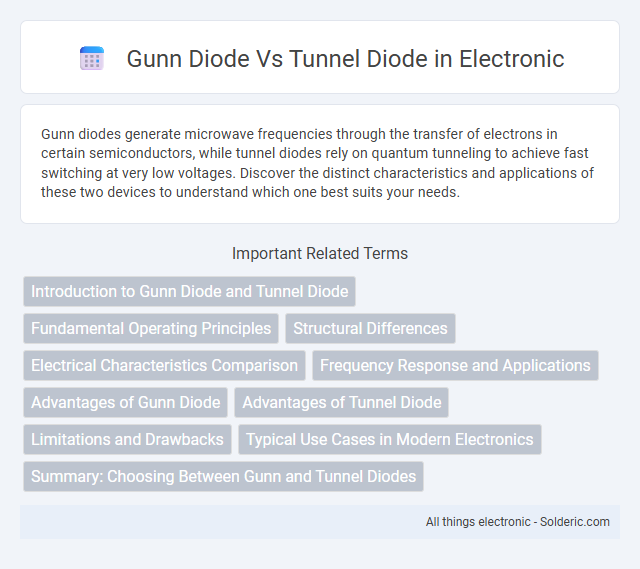Gunn diodes generate microwave frequencies through the transfer of electrons in certain semiconductors, while tunnel diodes rely on quantum tunneling to achieve fast switching at very low voltages. Discover the distinct characteristics and applications of these two devices to understand which one best suits your needs.
Comparison Table
| Feature | Gunn Diode | Tunnel Diode |
|---|---|---|
| Operating Principle | Transferred electron effect in bulk semiconductors | Quantum mechanical tunneling through a narrow depletion region |
| Material | Gallium arsenide (GaAs), Indium phosphide (InP) | Highly doped semiconductor junctions (e.g., GaAs, Ge) |
| Type | Unipolar device (n-type semiconductor) | Bipolar device (p-n junction) |
| Negative Resistance Region | Occurs due to electron transfer at high electric fields | Occurs due to tunneling at low voltage |
| Frequency Range | Microwave to millimeter-wave (up to ~100 GHz) | Microwave frequencies (few GHz to tens of GHz) |
| Applications | Microwave oscillators, amplifiers, radar | High-speed switching, oscillators, amplifiers |
| Biasing | Requires DC bias above threshold voltage | Typically forward biased near zero voltage |
| Construction | No junction, bulk semiconductor structure | Highly doped p-n junction with narrow depletion layer |
Introduction to Gunn Diode and Tunnel Diode
Gunn diodes operate based on the transferred electron effect in certain semiconductors, making them ideal for high-frequency microwave oscillators. Tunnel diodes utilize quantum mechanical tunneling due to their heavily doped p-n junctions, enabling extremely fast switching capabilities. Your choice between them depends on the specific application frequency and switching speed requirements.
Fundamental Operating Principles
Gunn diodes operate based on the transferred electron effect in certain semiconductors, creating microwave oscillations through the formation of charge domains under a high electric field. Tunnel diodes rely on quantum mechanical tunneling, allowing electrons to pass through a potential barrier at very low voltage levels, resulting in negative resistance. Understanding these fundamental operating principles helps you choose the right diode for high-frequency or low-voltage applications.
Structural Differences
The Gunn diode features a bulk semiconductor structure without a p-n junction, typically composed of n-type GaAs or GaN materials, utilizing transferred electron effects for microwave generation. In contrast, the tunnel diode consists of a heavily doped p-n junction with a very thin depletion region, enabling quantum mechanical tunneling of charge carriers for high-speed switching. These structural differences result in distinct operational principles and applications in high-frequency electronics.
Electrical Characteristics Comparison
Gunn diodes exhibit negative differential resistance due to electron transfer between energy valleys, operating primarily in the microwave frequency range with typical voltage thresholds around 1-2 volts and current densities up to 10^5 A/cm2. Tunnel diodes feature quantum mechanical tunneling through a narrow depletion region, resulting in high-speed switching with negative resistance occurring at much lower voltages, typically 0.1-0.4 volts, and current densities reaching up to 10^7 A/cm2. The Gunn diode's current-voltage characteristic shows a distinct N-shaped curve, while the tunnel diode displays a pronounced peak-to-valley current ratio reflecting its sharp tunneling behavior.
Frequency Response and Applications
Gunn diodes operate effectively in the microwave frequency range, typically from 1 GHz up to 100 GHz, making them ideal for applications such as radar systems, microwave oscillators, and high-frequency amplifiers. Tunnel diodes exhibit extremely fast response times in the terahertz frequency range due to quantum tunneling effects, which suit them for ultra-high-speed switching and microwave frequency detectors. While Gunn diodes are preferred for stable, continuous wave oscillations, tunnel diodes excel in high-frequency switching and amplification in low-power, high-speed circuits.
Advantages of Gunn Diode
Gunn diodes offer advantages such as higher power output and better frequency stability compared to tunnel diodes, making them ideal for microwave frequency applications. Their simple two-terminal construction and capability to operate at higher voltages result in enhanced efficiency and reliability in high-frequency oscillators. Gunn diodes are preferred in radar and communication systems due to their superior performance in generating stable microwave signals.
Advantages of Tunnel Diode
Tunnel diodes offer exceptional high-speed switching capabilities due to their negative resistance region, enabling ultra-fast response times ideal for microwave and high-frequency applications. Their low noise generation and stable operation under low voltage make them highly efficient for precision circuits in oscillators and amplifiers. For your designs requiring reliable performance at GHz frequencies, tunnel diodes provide significant advantages over Gunn diodes in terms of sensitivity and signal integrity.
Limitations and Drawbacks
Gunn diodes are limited by their lower frequency range, typically up to 100 GHz, and they require a high threshold voltage, which can lead to increased power consumption and thermal issues. Tunnel diodes, while capable of ultra-high-speed switching and operation at very low voltages, suffer from low output power and a narrow operating current range, making them less suitable for high-power applications. Both devices face challenges in scaling for modern high-frequency and high-power electronics due to their inherent physical and material constraints.
Typical Use Cases in Modern Electronics
Gunn diodes are primarily used in high-frequency microwave oscillators and amplifiers, making them ideal for radar systems, communication transmitters, and microwave signal generation. Tunnel diodes find applications in ultrafast switching circuits, frequency oscillators, and high-speed logic circuits due to their negative resistance and rapid response times. Your choice between these diodes depends on the required frequency range and switching speed in your electronic design.
Summary: Choosing Between Gunn and Tunnel Diodes
Gunn diodes are widely used for high-frequency microwave oscillators due to their ability to generate microwave signals without a PN junction, making them ideal for radar and communication systems. Tunnel diodes, featuring negative resistance caused by quantum tunneling, excel in ultra-fast switching and low-voltage oscillators, often applied in high-speed circuits and detectors. Your choice depends on the application's frequency range, switching speed, and voltage requirements, with Gunn diodes better for high-power microwave generation and tunnel diodes suited for ultra-fast, low-voltage electronic applications.
Gunn diode vs tunnel diode Infographic

 solderic.com
solderic.com